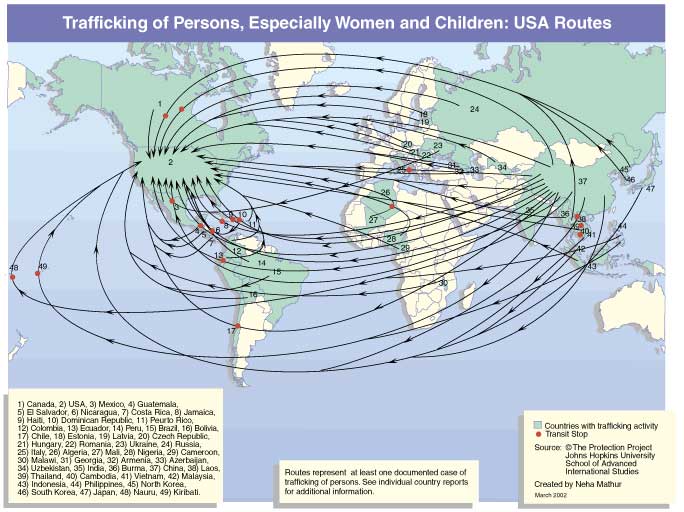

Dr. Chin instead allowed what was coming in from the field to shape her line of inquiry—for example, news reports of immigration raids were suggesting that not all of the women in the industry had been trafficked. “I started to dig into this somewhat reluctantly, but I also saw how the literature up to this point was so rigid and so…almost morally rarefied; it was very focused on sex trafficking and I felt that there was an unrecognized spectrum of experience that could only be seen by letting the women tell their stories.”
Utilizing an ethnographic method, Dr. Chin interviewed a number of sex workers from all over the world–including Asia, the Middle East, and Russia–living in Kuala Lumpur, Malaysia, shattering many of the prevailing views on the industry, and turning her research lens on non-trafficked women who willingly migrate to major global metropolises for sex work. Uncovering a wide spectrum of experiences, including the nature of the migration (serial, where women shuttle back and forth between home and a city vs. circular, where the women move within the global cities of a region and then move to another region), whether the workers moved with the aid of a syndicate or independently, and the motivation for their involvement in the industry, Cosmopolitan Sex Workers paints a complex picture of the structural forces of globalization at play and how the women very keenly understand and respond to them.

When I sat down with Dr. Chin to discuss her book, she outlined three of the key findings of Cosmopolitan Sex Workers. Firstly, migration for sex work is being globalized via an interconnected web of global cities that are nodes on this new frontier. For example, there are Senegalese women in Paris and Eastern European women in the Middle East—in other words, the same forces at play as a result of globalization are impacting this industry in predictable ways as well. The clients these women serve also travel to these destinations driven by the same economic motivations. Second, the common assumption that the workers are the “poorest of the poor,” is often not true. Some of the women are college graduates and/or come from middle class families. The women enter the business for a variety of reasons. For example, to assist their families, save money to start a business, get an education abroad, enjoy a certain more consumptive lifestyle, or simply earn income while travelling. These are the same reasons most workers migrate, regardless of their profession. From the women’s perspective, and the reason Dr. Chin prefers to use the term “sex work” rather than “prostitution,” sex work is work. Dr. Chin underlines the fact that doing this strictly for survival purposes is not always the case; for many of the women, this is a very calculated choice based on a careful consideration of their ability to earn income doing work that is commonly associated with—and available to–migrants, more specifically domestic work or other blue-collar labor. Sadly, the math weighs heavily on the side of sex work, which could earn them something akin to ten times as much as what they could bring in otherwise. Women’s monthly incomes (post-syndicate “taxes”) range between several thousand to tens of thousands of dollars. Thus, the impetus lies somewhere between a familiar, pragmatic strategy and an imperative.

Finally, Dr. Chin reflects on how neoliberal globalization facilitates the occurrence of the relatively new phenomenon of non-trafficked sex workers. Some of the women contract with syndicates or facilitating groups—one of those syndicates is explored in-depth in the book. Morphing from a traditional Chinese secret society or a triad to a new model of a transnational corporation, it reflects the environment of the global city. Whereas organizations such as this one previously dealt in debt bondage and extortion, the newly “cleaned up” climate of the global cities rendered those feudal vestige industries obsolete, if you will. This is a horizontal organization that conducts a lot of “legitimate” business, such as investing, and as a business organization also responds to the needs of its clients. What are those needs, you might ask? Predictably, fair-skinned women are in high demand, as are African women who are perceived to be “exotic” in Europe. To quote one of the members, “they want to make this a five star city; we will give them five star women.” Women who contract with such syndicates pay agreed-upon fees and a percentage of their income in return for syndicate-arrangement of their travel documents, transportation, board and lodging, and personal security. The spaces for the sex work are very varied as are the hierarchies of what was “in,” in other words: The physical characteristics of the women controlled where they could work and what prices they could command. Most of these women come into the cities under the auspices of either a tourist or a student visa. Though it deserves mentioning that some actually were receiving legitimate educations and not just using the visa status as a cover.
“The political economy of colonialism is not that terribly removed from the political economy of globalization and the sex industry illustrates that these ‘shadow economies’ are not afterthoughts or side effects but something that is inherently built into the system.”
“The political economy of colonialism is not that terribly removed from the political economy of globalization and the sex industry illustrates that these ‘shadow economies’ are not afterthoughts or side effects but something that is inherently built into the system,” Dr. Chin says. This system, in parallel with the same structural forces in place under colonialism, is highly gendered and racialized. Dr. Chin explains, “The book shows the gradations, the nuances of something that was previously thought to be very binary. I wanted to show that the women are responding, and rather astutely so, to structural forces at play. They understand the hypocrisies inherent in the system—the fact that their occupation is morally-condemned, yet at the same time, work such as being a domestic servant is so incredibly low-paying and subjects them to abuse as well.”
Cosmopolitan Sex Workers is available at Amazon and other booksellers.




Leave a Reply